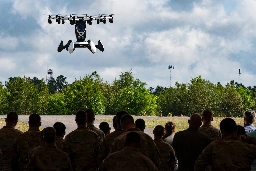Charting the Military’s Path Across the Technology Valley of Death Using Bar Napkin Math
Charting the Military’s Path Across the Technology Valley of Death Using Bar Napkin Math
Department of Defense leaders, technology developers, self-proclaimed innovators, and many others are obsessed with the apparent lack of adoption and slow

Submission Statement
A common refrain from the public and politicians alike is that the US military fails to adopt to new technologies widely available to the public. Products such as quadcopter drones and AI are frequently pointed to as evidence that the Department of Defense(DOD) ought to reform its acquisition processes in order to more rapidly integrate consumer/off the shelf(C/OTS) components. However, this approach fails to consider that integrating civilian technologies into military systems is not free of cost and that the requirements for military use are drastically different from that of the consumer market. Furthermore, it is important to recognize that not every defense project that fails to translate to an operational program is a failure and that many of the technologies that today appear as no-brainer C/OTS alternatives were originally seeded or nurtured by early investments by the DOD. This article puts numbers to these assertions and shows with a few ballpark estimates that the cost of innovation required to constantly integrate new technologies is far greater than most imagine and would require cutting into other essential aspects of readiness in order to sustain. The author concludes that the DOD should continue focusing its energy and resources on research and development while implementing reforms to assess what early-stage technologies show the most promise earlier in their life cycle.
Ray Khan is a 28-year veteran of the U.S. Air Force. Duties performed include engineer, program manager, tester, technologist, intelligence, information operations, search and rescue controller, electronic warfare operator, military diplomat, acquisitions professor, and innovator.
Department of Defense leaders, technology developers, self-proclaimed innovators, and many others are obsessed with the apparent lack of adoption and slow speed of integrating new technology into the military. There are many reasons that Defense Department “innovators” can point to for this apparent lack of adoption, ranging from the budget process to how the military sets requirements for new weapons developments to a whole host of bureaucratic and cultural challenges embedded in the acquisition process.
Many Department of Defense leaders and innovators incorrectly focus on increasing the transition rate of new technology into military operations. I will show, with simple bar napkin math, that increasing the technology transition rate is not fiscally feasible. The best path for the military is to continue to fund as much technology development as the budget allows and then conduct internal research and analysis to transition the technologies that will have the greatest “implementability” and “bang for the buck.” Based on my math, I believe that a sustainable technology transition rate for the military is between 1 and 10 percent. Also, the percentage of projects successfully fielding is even smaller depending on Department of Defense plans and resources, and advancements by America’s adversaries.
I believe the Department of Defense cannot hamstring its technologists and needs to continue to fund as many research and development projects as possible, even if most of the technologies will not transition. During the early stages of a technology development project, the Department of Defense will likely not be able to accurately and/or methodically figure out a project’s value (bang for the buck). More importantly, the military needs to let its technologists mature the projects for two to five years with a “fail fast” mindset, while “desired” technology projects may be allowed a longer maturation schedule. Once technology development projects start to prove their legitimacy, the Defense Department needs its innovators to start doing the hard work of research and analysis to assess the projects implementability and sustainability. This assessment will determine a project’s value (bang for the buck) and allow for the worthiest projects to move forward towards successful fielding.